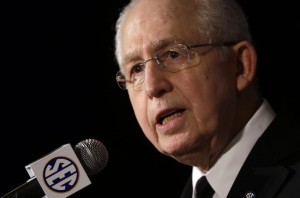NCAA being killed from within and without
By DERON SNYDER
The NCAA that we’ve come to know and despise is in critical condition with a prognosis that suggests the end is near.
The equivalent of flesh-eating bacteria are close to devouring the body from within. Outside, it is suffering injury from a series of blows that ultimately could be fatal.
External attacks include the trial in Ed O’Bannon’s class-action antitrust lawsuit, which enters day four Thursday in Oakland. Just as those proceeding got underway, the NCAA announced a settlement to pay $20 million to current and former college athletes who sued in a lower-profile case involving their likenesses in video games.
Organizations such as the National College Players Association also pose great harm. The NCPA has led a series of reforms to improve student-athletes’ rights and benefits since 2001, but the biggest victory yet could be on the horizon.
Northwestern is appealing a National Labor Relations Board regional ruling that the school’s scholarship players have the right to unionize; the full NLRB will hear the appeal later this year.
Even if the full board overturns the decision – or even if a majority of the team voted not to unionize when secret ballots were cast in April – damage has been done and the issue will continue to simmer on back burners.
But the greatest threat to the NCAA as we know it could come from its own members.
We could be on the verge of an official split that acknowledges the cavernous gulf between the “Power 5” (Atlantic Coast Conference, Big Ten, Big 12, Pac-12, Southeastern) and the “Weaker 5” (American Athletic, Conference USA, Mid-American, Sun Belt, Mountain West).
The fat cats in Division I, being pummeled with lawsuits and public opinion, want to make concessions to the obvious – “We’re rich!”But they’re being held down by the small fry. And that frustration isn’t aimed solely at schools in the Weaker 5 (also known as the Football Championship Subdivsion).
It’s understandable why schools like Ohio State (nearly 58,000 students) are questioning a system in which Ohio Wesleyan (fewer than 2,000 students) has the same voting muscle. That arrangement is making less and less sense as Power 5 bankrolls grow thicker and thicker.
Some are ready to separate from the riffraff, which would allow the well-heeled and moneyed to operate under their own rules on athletes’ compensation … like adopting the proposed $2,000 stipend for Div. I athletes.
The full NCAA membership shot it down because some smaller schools can’t afford it.
“If you’ve got a $6 million athletic budget, you shouldn’t be worrying about what I do,” University of Washington president Michael Young told The Seattle Times. “You’re never going to compete with us. We don’t recruit the same players. We don’t even play on the same field. It just doesn’t matter.”
According to a USA Today database, Washington’s athletics department had revenue of $85 million in 2013.
Florida Atlantic had $25 million in revenue; a fellow Div. 1 member in the Sunshine State had $130 million.
“We’re in a squeeze here,” Florida president Bernie Machen told reporters last month during the SEC meetings. “There are now six lawsuits that name our conference in them that specifically have to do with the whole cost of attendance and stuff like that. We would like to make changes, but we can’t because the NCAA doesn’t allow us to. We’re really caught between a rock and a hard play. We desperately would like some flexibility.”
If the NCAA doesn’t bend, SEC commissioner Mike Slive favors a break, a separate division for the Power 5. He said that move would keep the championship formats in place, especially March Madness, yet allow other schools to stay on the porch while the big dogs run.
“We hope everyone realizes we are moving into a new era and this is the way to retain your collegiate model,” Slive said. “It would be a disappointment and in my view a mistake not to adapt the model.
“This is a historic moment. If we don’t seize the moment, we’ll make a mistake.”
Public opinion, the O’Bannon case and the possibility of unionization have forced the NCAA into an adapt or die position. Change is inevitable. Eventually, there’s going to be a trickle-down effect with those billions of dollars.
Either the NCAA reconfigures by performing surgery on itself. Or judges and lawmakers will pick up scalpels and make their own incisions.
In many respects, that adaptation means death to what the NCAA has been for so long. The new thing will have some resemblance, but the old creature will be dead and gone.
With all due respect, good riddance.
 Follow
Follow

